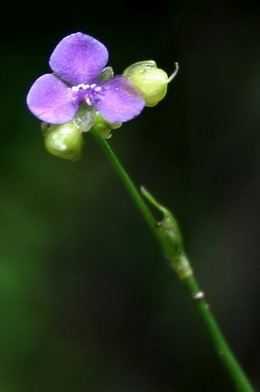Murdannia nudiflora: Tiny Dayflower Kin
In India the Doveweed is a famine food. That should give you some idea of how it lines up in the culinary kingdom. The Chinese, however, put young shoots in soup.
This is quite understandable to me. The Doveweed is in the greater Commelina family and that family has fallen some in my favor. Quite a few members of that family are reported to be edible raw and I am beginning to think few are. They certainly should be cooked. Blossoms, and young tips, can be raw exceptions for salads, but I have had a few upset stomachs eating raw adult members of this family. I think that is from calcium oxalate in the older leaves. Thus I recommend cooking for all of them. See the entry for “Dayflowers.”
The Doveweed grows from Virginia south and west to Texas, and in most subtropical to tropical areas of the world, usually infiltrating commercial crops. It’s quite an invasive weed for a ground hugger. The flower is also known by several names, both common and botanical. Naked Stem Dewflower is one. In Uganda they call it Mickey Mouse because the blossoms resemble you-know-who. Botanically it is commonly called Murdannia nudiflora and Aneilema nudiflorum. It’s even been called a Commelina and Tradescantia and some six others names. And of course, every botanist is right.
As for the botanical name, Murdannia nudiflora (mer-DAN-nee-ah noo-dee-FLO-ree-ah) Nudiflora means “naked flower” and Murdannia was named for Munshi Murdan Ali, plant collector and keeper of the herbarium at the Saharanpur Botanic Gardens in India around 1840.
Green Deane’s “Itemized” Plant Profile: Doveweed
IDENTIFICATION: Murdannia nudiflora: Annual herb, roots fibrous, slender, stems numerous, creeping, simple or branched, smooth. Leaves nearly all growing on the stem, hairy throughout, sometimes smooth except for a hirsute line along mouth slit; leaf blade linear or lanceolate, smooth or sparsely bristly on both surfaces, end round or pointed. Angled zig-zagging branches. Flowers in terminal panicles, or solitary, with several densely arranged flowers; petals purple, obovate-orbicular. Seeds 2 per valve, yellow-brown, deeply pitted, or shallowly pitted and radiate white warts.
TIME OF YEAR: Summer into early fall
ENVIRONMENT: Often found in a dense mat in damp areas
METHOD OF PREPARATION: Young tips cooked, blossoms raw or cooked, preferably cooked. Leaves can be used as poultices.


